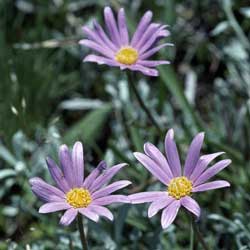Calotis scabiosifolia
Rough Burr-Daisy
Calotis scabiosifolia Sond. & F.Muell.
Calotis scabiosifolia, commonly known at the Rough Burr-Daisy, is part of the Asteraceae family. The plant is an erect, perennial forb, or non-woody herb, growing to 45cm high. The flowers are a striking purple/mauve or white colour, and are approximately 3cm in diameter. It has grey-green basal and upper stem leaves. The leaves are 10-18cm long by 5cm wide and are sharply toothed or lobed. The plant’s fruits (achenes) are commonly called burrs and are typical of the burr-daisy group.
Calotis scabiosifolia flowers in spring or early summer. In the right conditions, or when well maintained by watering, it may flower throughout the year. The burrs are not as sharp or strong as some of the other burr-daisy species making it a more desirable garden plant.
 Calotis scabiosifolia is found from southern Queensland through New South Wales and Victoria and into eastern South Australia. It is common in pasture land with heavy grey clay or duplex soil.
Calotis scabiosifolia is found from southern Queensland through New South Wales and Victoria and into eastern South Australia. It is common in pasture land with heavy grey clay or duplex soil.
They are two varieties of Calotis scabiosifolia: Calotis scabiosifolia var. scabiosifolia and Calotis scabiosifolia var. integrifolia. The main difference between these two is that var. scabiosifolia has glabrous (hairless) achenes while var. integrifolia has a small amount of dense apressed hairs on face of the achenes. The integrifolia variety is more common in southern areas of New South Wales and Victoria.
Calotis scabiosifolia is a horticulturally desirable plant mainly because it is a hardy native - both drought and frost tolerant. It can even withstand occasional inundations. It can be used as an edging plant or in rockeries and is particularly attractive when grown in areas of mineral mulch due to the pleasant contrasting effect with the grey-green foliage and purple flowers.
Calotis scabiosifolia needs to be grown from seed in soil ranging from heavy clay to sandy loam, where the top soil is at least 25cm deep. To ensure the seeds germinate they should be soaked in lukewarm water before planting. The ideal germination temperature is 20-25ºC. It can be grown in seed tubes until established, then transferred into a garden beds or pots.
Once well established, which takes between 1-3 months, it requires little watering, unless continued flowering is desired. In this case it should be watered regularly, especially in the heat of summer or if not grown in clay soils. It prefers areas of full sun, but can be grown in partial shade. A rooting hormone can be used to help the plant become established more quickly. It does not require a low phosphorus fertiliser and likes almost any NPK (Nitrogen, Phosphorus, Potassium) or micro-nutrient fertiliser.
Once the plant is well established it requires little maintenance. It can be susceptible to weed grass growing up from its tuft and these should to be removed manually. Heavy mulching may lead to stunted growth so light mulch is all that is required. Native mulch is ideal or mulch with a large range of particle sizes.
Text by Daniel Warner (Botanical Intern 2008)
Name Meaning: Calotis scabiosifoliaCalotis– derived from the Greek kalos meaning beautiful and otis meaning ear (the first species named in the genus, Calotis cuneifolia, has an ear shaped pappus). scabiosifolia – a reference to the ancient Greek belief that plants with rough leaves could be used to treat scabies , and so any plant with rough leaves was called scabiosifolia. |
Acknowledgements
Joe McAuliffe, Horticultural Staff at the Australian National Botanical Gardens
Dr Rosemary Purdie, Australian National Herbarium
References
Black, J.M. (1977) Flora of South Australia. Government Printer, Adelaide.
Cunningham, G., Mulham, B., Milthorpe, P. & Leigh, L. (1993) Plants of Western New South Wales. Inkata Press, Melbourne.
Foreman, D.B. & Walsh, N.G. (Eds.) (1993) Flora of Victoria, Melbourne Inkata Press.
Mcauliffe, J. (2008) Australian National Botanic Gardens. Personal communication.
Spencer, R. (Ed.) (2002) Hoticultural Flora of South-Eastern Australia. University of New South Wales Press, Sydney.
Stanley, T. D. & Ross, E. M. (1983) Flora of South-Eastern Queensland. Queensland Department of Primary Industries, Brisbane.
![An Australian Government Initiative [logo]](/images/austgovt_brown_90px.gif)



